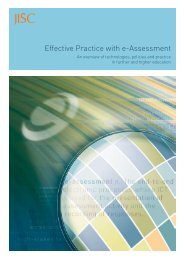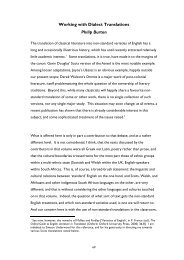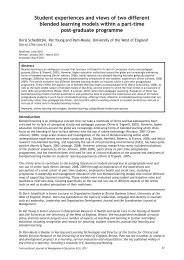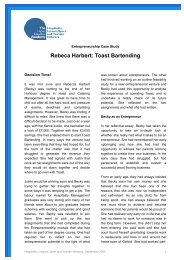Embedding Building Information Modelling (BIM) within the taught ...
Embedding Building Information Modelling (BIM) within the taught ...
Embedding Building Information Modelling (BIM) within the taught ...
Create successful ePaper yourself
Turn your PDF publications into a flip-book with our unique Google optimized e-Paper software.
Introduction – background to <strong>the</strong> introduction of <strong>BIM</strong><br />
Over recent years, <strong>the</strong> attention that building information modelling (<strong>BIM</strong>) has been receiving<br />
has been steadily growing, and this has been substantially increased through <strong>the</strong> Government’s<br />
intervention, with its <strong>BIM</strong> Report and Government Construction Strategy (GCS) both published in<br />
2011. The impact of <strong>the</strong>se two documents on <strong>the</strong> industry has been significant and ultimately<br />
will lead to all public sector departmental spending being channelled through a supply chain<br />
which is <strong>BIM</strong> ‘level 2’ compliant. Indeed, <strong>the</strong> Government has mandated that all public procured<br />
projects are to be delivered through, by or with <strong>BIM</strong> by 2016. The ubiquitous Bew-Richards<br />
maturity diagram (noted in <strong>the</strong> reports mentioned above and included in this report at<br />
Appendix 2) defines ‘level 2’ as file-based collaboration and library management. The purpose<br />
behind <strong>the</strong> Government ‘push’ at this time is in order to derive significant improvements in<br />
cost, value and carbon performance, as has been cited by <strong>the</strong> industry for some time (see<br />
Latham (1994), Egan (1998), Wolstenholme (2009), Andrews, et al 2009). In addition to <strong>the</strong><br />
challenge of up-skilling <strong>the</strong> current work force, this has significant implications for higher<br />
education in developing future built environment professionals with <strong>the</strong> necessary skills to work<br />
in new ways, beyond <strong>the</strong>ir traditional disciplines. Alongside this, it is recognised that <strong>the</strong>re will<br />
be a need to work with <strong>the</strong> professional institutions in addressing new requirements in <strong>the</strong><br />
accreditation of courses. Altoge<strong>the</strong>r this provides <strong>the</strong> construction industry with its greatest<br />
challenge and opportunity to revolutionise working practices with <strong>the</strong> aim of increasing<br />
productivity and efficiency. The GCS proposes that its recommendations, which include <strong>BIM</strong><br />
alongside a call for greater collaboration and new contract formats, should lead to savings<br />
targeting 20% of both capital and operational budgets. Fur<strong>the</strong>r information and reference<br />
sources are provided at <strong>the</strong> end of this report.<br />
Currently <strong>the</strong>re is very little regulation directly relating to <strong>the</strong> production and use of<br />
information relating to <strong>BIM</strong> in <strong>the</strong> UK. Much of <strong>the</strong> early momentum in respect of <strong>the</strong><br />
approach, relevant standards and research has emanated from <strong>the</strong> US and is revealed in output<br />
such as that produced by <strong>the</strong> American Institute of Architects (AIA), ‘consensus docs’,<br />
Construction Operations <strong>Building</strong> <strong>Information</strong> Exchange (COBie) and <strong>the</strong> dominance of <strong>the</strong><br />
world’s leading vendor for <strong>BIM</strong> authoring software, Autodesk. The effect of technology<br />
providers and software vendors is also a key matter in <strong>the</strong> formulation of <strong>BIM</strong> strategy and<br />
indeed learning, which needs careful consideration. The UK Government’s position in relation<br />
to <strong>the</strong>se matters has been to be non-prescriptive and adopt a software neutral position, while<br />
its governance and guidance leaves <strong>the</strong> detail for delivering <strong>the</strong> outputs and outcomes it is<br />
demanding to <strong>the</strong> supply chain itself.<br />
In 2011 <strong>the</strong> UK Government established its <strong>BIM</strong> Implementation team whose articulation of <strong>the</strong><br />
process and promotion of <strong>the</strong> benefits of <strong>BIM</strong> <strong>within</strong> Government departments has had a great<br />
impact, and its influence continues to grow. From setting <strong>the</strong> agenda in <strong>the</strong> 2011 report, a<br />
number of task groups have been set up each of which seeks to address a specific area or topic<br />
related to <strong>the</strong> adoption and implementation of <strong>BIM</strong>. This includes <strong>the</strong> training and education<br />
task group which has had representation covering <strong>the</strong> HEIs, training organisations and bodies<br />
such as construction skills and Construction Industry Council (CIC).<br />
As a result, <strong>the</strong> amount of information and data, and general progress being made in supporting<br />
<strong>BIM</strong> implementation in <strong>the</strong> UK is rapidly increasing with UK standards guides (e.g. <strong>Building</strong><br />
<strong>Information</strong> Mode (<strong>BIM</strong>) Protocol, Standard Protocol for use in projects using <strong>Building</strong><br />
<strong>Information</strong> Models, CIC 2013) ei<strong>the</strong>r produced and available under free licence or imminent in<br />
release through <strong>the</strong> B/555 Technical Committee Roadmap. It is against this backdrop that BAF<br />
4
















